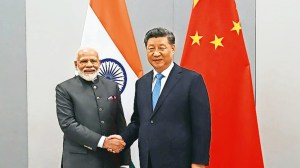The Rise of the Fall
Mukherjee agrees. ‘‘The drape is a very forgiving piece of cloth,’’ he says. ‘‘It’s almost like a chastit...

Distinctly ‘unwestern’ in shape, Indian clothes are softer, more fluid and are ‘wrapped’ (or draped) instead of being ‘worn’. While we may have westernised the sari and the salwar kameez —worn a sari with an unconventional blouse or a kurti with trousers—we haven’t entirely switched over.
‘‘Indians will always love the Indian dress,’’ says Kolkata-based designer Sabyasachi Mukherjee. ‘‘There’s so much confusion in the world where identities are concerned. And here we are—still holding on to ours. It’s especially important now, when global focus on Indian fashion has never been more intense,’’ says Mukherjee, who was recently picked up by the prestigious Brown’s boutique in London.
Especially in the late 1990s, interpretations of non-western clothing traditions hit international catwalks. Top league designers such as Valentino Garavani, Alexander McQueen and John Galliano were inspired by the Orient. Gianni Versace and Galliano had adapted the sari, Romeo Gigli created a fantasy in the manner of the Russian ballet and Rifat Ozbek romantically interpreted his native Turkish dress. From 1995 onwards, several designers brought out their interpretation of the salwar kameez. The bespoke Nehru jacket, a softer option to the boxy broad-shouldered jacket, was preferred by the sensitive New Age man.
Indians prefer softer flowing fabrics and richer weaves to a harder warp. ‘‘Like our clothes, we’re feminine, lyrical and non-aggressive,’’ says Mukherjee. The sari, or the drape, will always be with us—be it a dupatta, sarong, lungi or even turban. ‘‘When a foreigner thinks of India, he thinks of a woman in a sari,’’ says Delhi-based designer Suneet Varma. ‘‘Very few cultures in the world are still associated with their attire—maybe a Scottish kilt, a Japanese kimono or a Chinese cheongsam. And how many of them are still wearing their ethnic clothes?’’ he adds. Varma also points out how the drape of the sari can identify the region one hails from. ‘‘I can tell you a thousand ways of draping the five-and-half metres.’’
“The sari was initially worn without blouse,” says designer Ritu Kumar. “Later, it came with a blouse and stitched skirt. With the more structured salwar kameez taking over, the sari became occasion wear, sexy and embellished. But it is also corporate wear, it is a business suit with your signature on it.”
A lot of India’s obsession with its indigenous clothing has to do with our culture—we’re still a very traditional people. But designers point out India isn’t exactly a ‘‘body beautiful’’ country either. ‘‘A sari is a supremely elegant garment,’’ says Delhi-based designer Tarun Tahiliani. ‘‘Even a large-sized woman can wear it and look elegant. It can hide what you want and show what you want to show. And one size fits all.’’
A majority of Indian designers make Indian clothes, which account for almost 90 per cent of their income. But is it a bane or a boon for those beseeching foreign shores? ‘‘A boon,’’ says Tahiliani, who sells out of Italy, Hong Kong, Spain and the USA. ‘‘They don’t want another suit-maker, they want some exotica.’’
Though younger ‘westernised’ Indians wear traditional clothes only as occasion wear, the sari continues to thrive. Its corrupted forms— with T-shirts, corsets, boots, body suits—have only ensured its longevity.
And maybe, immortality.
Photos




- 01
- 02
- 03
- 04
- 05


























